Vietnam has emerged from the Covid-19 battlefield after 1.5 million infections and 30,000 deaths with scars to show and lessons learned.
From 1,400 cases and 35 deaths at the end of 2020 the coronavirus situation has changed considerably, with significant increases in both the number of infections and deaths.
The Alpha and Delta variants, with their much higher transmissibility and ability to evade immune responses, have created a much bleaker picture in the country’s fight in contrast with its previous achievements.
But the pain in the past year notwithstanding, the nation of 98 million has also learned to roll with the punches, adapting to life with the coronavirus and shifting its defense strategy.
The highlight is a historic vaccination campaign, which has seen Vietnam turn from a country that was sluggish in administering vaccines to having the third fastest immunization rate in the world.
As the Omicron variant casts a shadow over the globe and winter months approach, we take a look back at the country’s journey in 2021 in its coronavirus fight.
Third wave
On January 2 Vietnam recorded its first confirmed case of the Alpha coronavirus variant when a woman, one of 305 passengers on a flight to Vietnam from the U.K. on December 22, was found infected.
Three days later, on January 5, then Prime Minister Nguyen Xuan Phuc ordered the suspension of all flights to Vietnam from regions with new variants, starting with the U.K. and South Africa.
On January 28 two cases of local transmission were found, a 34-year-old woman worker at the Poyun Company in Hai Duong Province and a 31-year-old man working at the Van Don International Airport in its neighbor Quang Ninh. They were the first in the country after 55 days without local transmission.
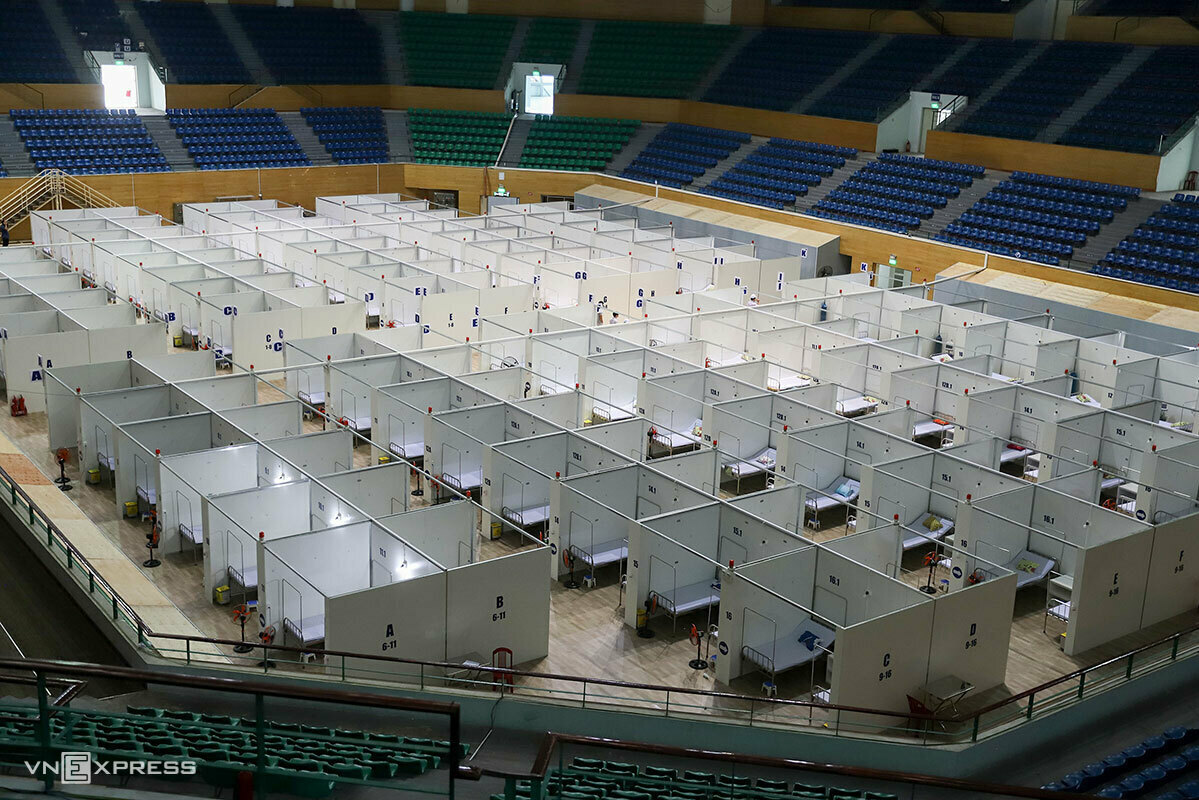 |
|
Beds are set up at a Covid-19 field hospital in Hai Duong, February 6, 2021. Photo by VnExpress/Nguyen Dong |
The Hai Duong woman had contracted the U.K. variant, and 82 more people associated with the two people were announced as infected the same day, prompting province authorities to immediately begin social distancing.
Quang Ninh suspended all public transportation, including flights, on January 28 before shutting food and drink establishments and karaoke parlors a day later.
Also on January 29 the Ministry of Health required all health workers to be tested for Covid. Within the next few days, localities across the country began deploying their own coronavirus prevention measures like lockdowns, social distancing and making students study online.
On February 1 the capital closed karaoke parlors and dance clubs and restricted non-essential activities with large gatherings. Hanoi also scrapped plans for almost all fireworks for the Lunar New Year except at Thong Nhat Park. By mid-February it also shut street stalls and coffee shops.
Throughout February Vietnam continued to ramp up preventive measures like mass testing, contact tracing, isolation, social distancing, and online classes for students.
Only in early March did major cities like Hanoi and HCMC and Covid hotspot Hai Duong begin to ease restrictions and allow certain non-essential activities to resume.
Cases still cropped up here and there throughout March, but the situation was mostly under control in the country.
For most of April Vietnam saw a period of relative calm. In the third wave, which lasted around two months, around 910 cases were found.
But it was in late April that the nightmare began for Vietnam.
Fourth wave
Ahead of the Reunification Day-Labor Day holidays at April-end and the start of May localities began to suspend certain festival activities and closed pedestrian streets fearing potential outbreaks.
On April 27 a receptionist at a hotel in the northern province of Yen Bai tested positive for the coronavirus. A week earlier a group of Indian engineers had quarantined in the hotel, and four of them were later found infected.
The cases were found just days before the holidays when people would travel across the country in large numbers. No one knew then, but it was the beginning of the fourth Covid-19 wave, the most deadly yet, one that has infected 1.5 million people and killed over 30,000.
A few days later, on April 29, a new community outbreak was confirmed in the northern Ha Nam Province after a man returned to Vietnam from Japan. Despite having tested negative thrice and completed his quarantine period, the man was found infected anyway and spread the virus in the community.
The Ha Nam patient was also the source of infection of a case in HCMC, which broke the city’s streak of no community transmission in 75 days, and community transmissions in Hanoi, where the disease-free period had been 72 days.
HCMC decided to shut down non-essential businesses like bars and karaoke parlors on April 30, a decision followed by Hanoi as well.
The Ha Nam case was also connected to outbreaks in other areas like Hung Yen Province.
Many provinces and cities decided to close down non-essential businesses as the situation deteriorated steadily.
Outbreaks also started to crop up elsewhere starting early May, for example in Vinh Phuc Province and Da Nang City.
On May 5 dozens of cases of infection were detected at Hanoi’s National Hospital for Tropical Diseases, one of the nation’s foremost Covid treatment facilities. The hospital went into lockdown the same day.
The outbreak at the Hanoi hospital was soon linked to cases in Bac Ninh, Thai Binh, Hung Yen provinces and at other medical facilities like the 105 Military Hospital and K Hospital. Several hospitals and others had to be locked down as a result.
By mid-May Hanoi had recorded 70 Covid cases in the community and 100 others at the National Hospital for Tropical Diseases and K Hospital.
On May 8 a worker at Bac Giang’s Van Trung Industrial Park, the province’s largest with hundreds of thousands of workers, was found infected. The case was associated with the cluster at K Hospital, and soon more cases were detected in other industrial parks in the region.
Other provinces like Bac Ninh, Bac Giang, Ha Nam, Vinh Phuc, Hai Duong, Hung Yen, Thai Binh, Yen Bai, Lang Son, Quang Ninh, Quang Tri, Ha Tinh, Thua Thien-Hue, and Nghe An, and Hai Phong City also saw new cases, prompting social distancing and lockdowns of various intensities.
Bac Giang and Bac Ninh were two hotspots with the highest numbers of daily infections due to outbreaks at industrial parks where thousands of workers mingled with each other daily.
As a result, Bac Ninh began social distancing in its capital town on May 7 and Bac Giang on May 19.
Other locations in the two provinces also saw restrictions imposed, industrial parks and tenants began to adopt measures that would allow workers to work, eat and sleep on company premises to prevent travel and preclude possible infection.
On May 15 Vietnam recorded its 36th Covid death at the National Hospital for Tropical Diseases and the first since the second wave of the disease in Da Nang back in July-August 2020.
On May 18 a person was diagnosed with Covid in HCMC but with no obvious source of infection. It was the first community case in 20 days.
It was the beginning of a string of outbreaks that turned Vietnam’s economic spearhead into a Covid warzone for the next few months.
More clusters continued to be detected in the city, leading to lockdowns at multiple locations. On May 26 a husband and wife couple belonging to the Revival Ekklesia Mission, a self-described Christian congregation, were found infected. In the next few days the congregation revealed itself to be a super spreader.
HCMC on May 27 ordered a ban on dine-in services at eateries and coffee shops and barbershops among others as 25 cases related to the new cluster were detected within 12 hours.
Multiple lockdowns also commenced in locations associated with the infections.
On May 31 a citywide social distancing mandate was imposed on a single day’s notice. News of the lockdown led to residents rushing to supermarkets to stock up on food and other necessities despite authorities’ assurances there would be no food shortages.
Meanwhile, the outbreaks in the city, involving both the Alpha and Delta variants, had begun to spread to neighboring provinces resulting in thousands of new cases. Localities also began to test and isolate those coming from HCMC.
The Delta variant’s high transmissibility meant several infection cycles were completed rapidly, making contact tracing very difficult. Outbreaks without obvious sources of infection began to appear as a result.
By June 25, six localities in southern Vietnam: HCMC, Tay Ninh, Phu Yen, Binh Thuan, Binh Duong and Tien Giang were undergoing social distancing orders of various levels. The daily number of cases across the country was in the hundreds.
By late June some people who had come into close contact with patients were allowed to self-isolate at home to relieve the burden on the medical system.
The number of infections in HCMC was beginning to rise during the month as more outbreaks were detected, including major ones like at Pouyuen Vietnam, which employs around 56,000 workers.
On June 20 the city imposed several measures to prevent the virus’s spread, including suspending taxi and bus services and limiting gatherings.
The number of cases went past Bac Ninh’s on June 20.
By July 3 the infection tally had topped 5,000, the worst case scenario painted by authorities 45 days earlier.
The number then went past the 6,000 mark just one day later, and the southern metropolis had eclipsed Bac Giang and turned into Vietnam’s biggest hotspot.
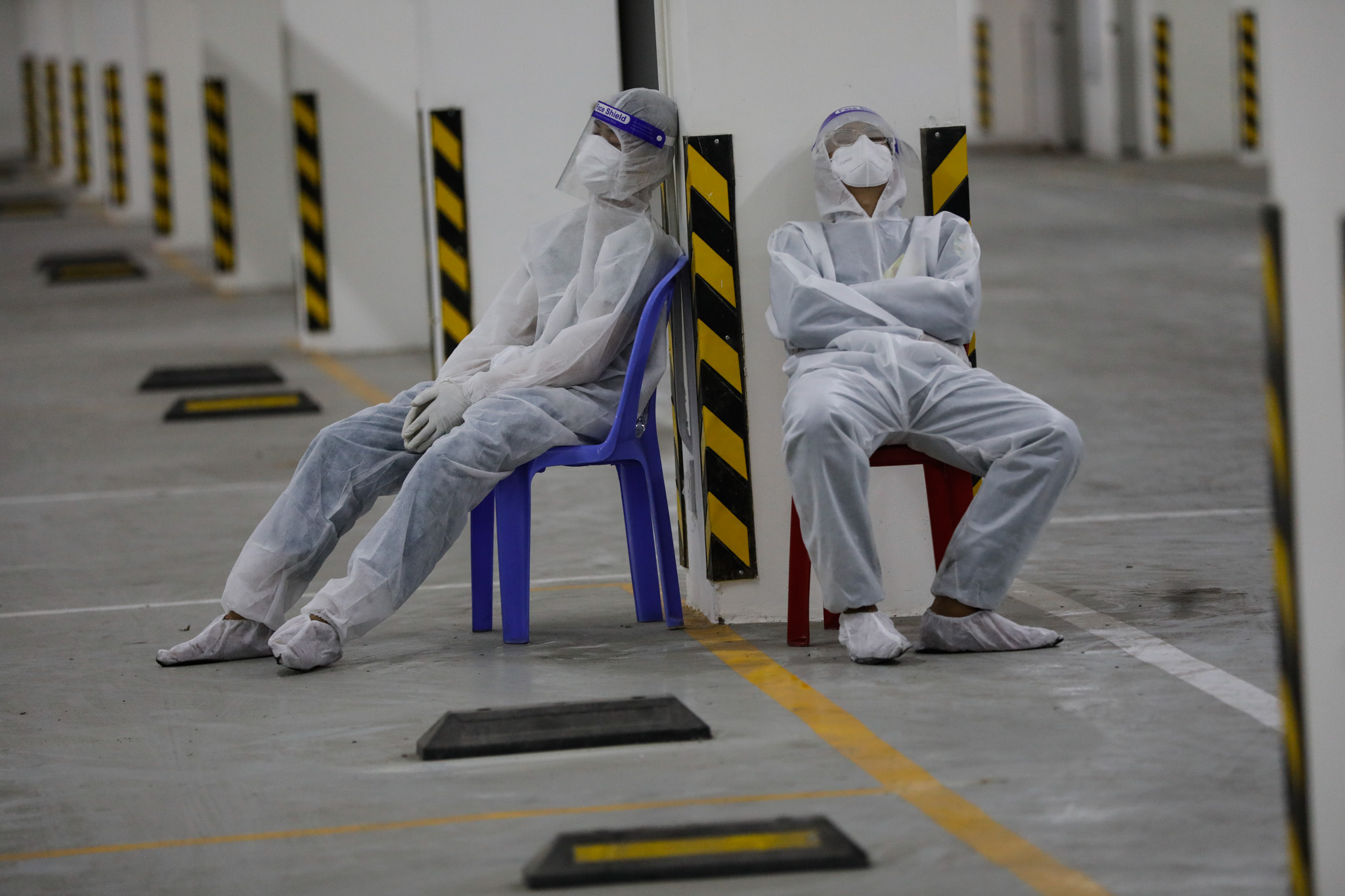 |
|
Two medics rest at a Covid-19 field hospital in HCMC, July 2021. Photo by VnExpress/Huu Khoa |
On July 9 city authorities tightened the lockdown for a period of 15 days, which included further transportation restrictions like banning ride-hailing services. At that point the city had already undergone over a month of restrictions, which had begun on May 31.
Nearby provinces like Dong Thap, Binh Phuoc and An Giang also began to impose restrictions days after HCMC did.
Hanoi began closing down non-essential businesses and like coffee shops and hair dressers’ before making social distancing more stringent on July 24.
By mid-July Vietnam was recording around 3,500 cases a day, with HCMC accounting for more than half. On July 16 the infection tally across the nation exceeded 40,000 cases.
On July 26 HCMC authorities urged people not to leave home after 6 p.m. except for medical emergencies or tasks related to fighting the pandemic. Similar restrictions were adopted by some other localities like Bac Lieu Province.
Amid the virulent outbreak, many people in HCMC decided to leave the city and return to their hometowns, hoping to escape it despite knowing they would need to test and quarantine for that. But fearful that an uncontrolled exodus could cause new outbreaks, authorities organized buses to take people back home in an orderly fashion.
A report in October by the General Statistics Office said around 1.3 million people abandoned cities across the country and returned to their hometowns.
Travel papers had to be checked at Covid-19 checkpoints, and this inadvertently caused traffic jams and, consequently, large crowds around them, defeating the original purpose of setting them up.
On July 31 authorities in several southern localities announced the extension of social distancing while some others imposed new restrictions.
Throughout August localities carried on with social distancing and measures as outbreaks persisted.
Toward the end of the month the country began to tally daily infections in five figures.
In mid-August HCMC began to trial treating mild cases at home amid a surge in the outbreak. By the end of the month the city had recorded over 200,000 cases. During peak periods there were 7,000-8,000 cases in a single day.
On August 19 Prime Minister Pham Minh Chinh said the military would deploy personnel for buying and delivering food and other essential items to people’s homes in HCMC, which would be locked down starting in four days’ time.
Hundreds of soldiers and police officers arrived in the city on August 21. Their tasks also included conducting tests and others.
As the pandemic continued to worsen, authorities in places like Hanoi, HCMC and Binh Duong Province also began to evacuate residents living in hotspots and moved them into quarantine zones to contain the spread.
But the number of cases stubbornly refused to decrease as the government had hoped, still remaining at around 10,000 daily.
On September 1 PM Chinh said lockdowns could not be maintained forever considering their impact on the economy and people’s lives.
It was the second time the government had brought up the idea of living with Covid-19, the first being at a Cabinet meeting on August 29, when Chinh said the pandemic could not be completely contained and requires adaptation.
Four days later he said Vietnam needs to have a plan for safe adaptation to the coronavirus once it had enough vaccines.
On September 7 HCMC allowed food and beverage establishments to resume takeaway services after a two-month hiatus.
Other localities with the outbreak relatively under control also began to loosen restrictions.
New normal
On September 11 Chinh instructed the health ministry to finalize a Covid-19 fighting plan focusing on vaccination, testing and treatment for Vietnam to enter the “new normal” in 2022.
By mid-September Hanoi, HCMC and some other localities had begun to resume delivery services and some other activities.
Hanoi stopped requiring travel papers and removed several Covid checkpoints starting September 21.
HCMC too withdrew the travel paper requirement on September 30.
Toward the end of September the daily count in the country began to subside, dropping to four digits.
In early October troops began to gradually leave HCMC about a month and a half of hard work.
Flights resumed on some domestic routes on October 10.
On October 11 the government issued a temporary guideline classifying areas based on their coronavirus threat as low, medium, high, and very high risk.
The risk level would depend on a number of factors, including the number of infections, population density and vaccine coverage. Areas designated as lower risk faced fewer restrictions than others.
On October 14 Hanoi allowed the resumption of a number of activities, including eating indoors and taxi operations.
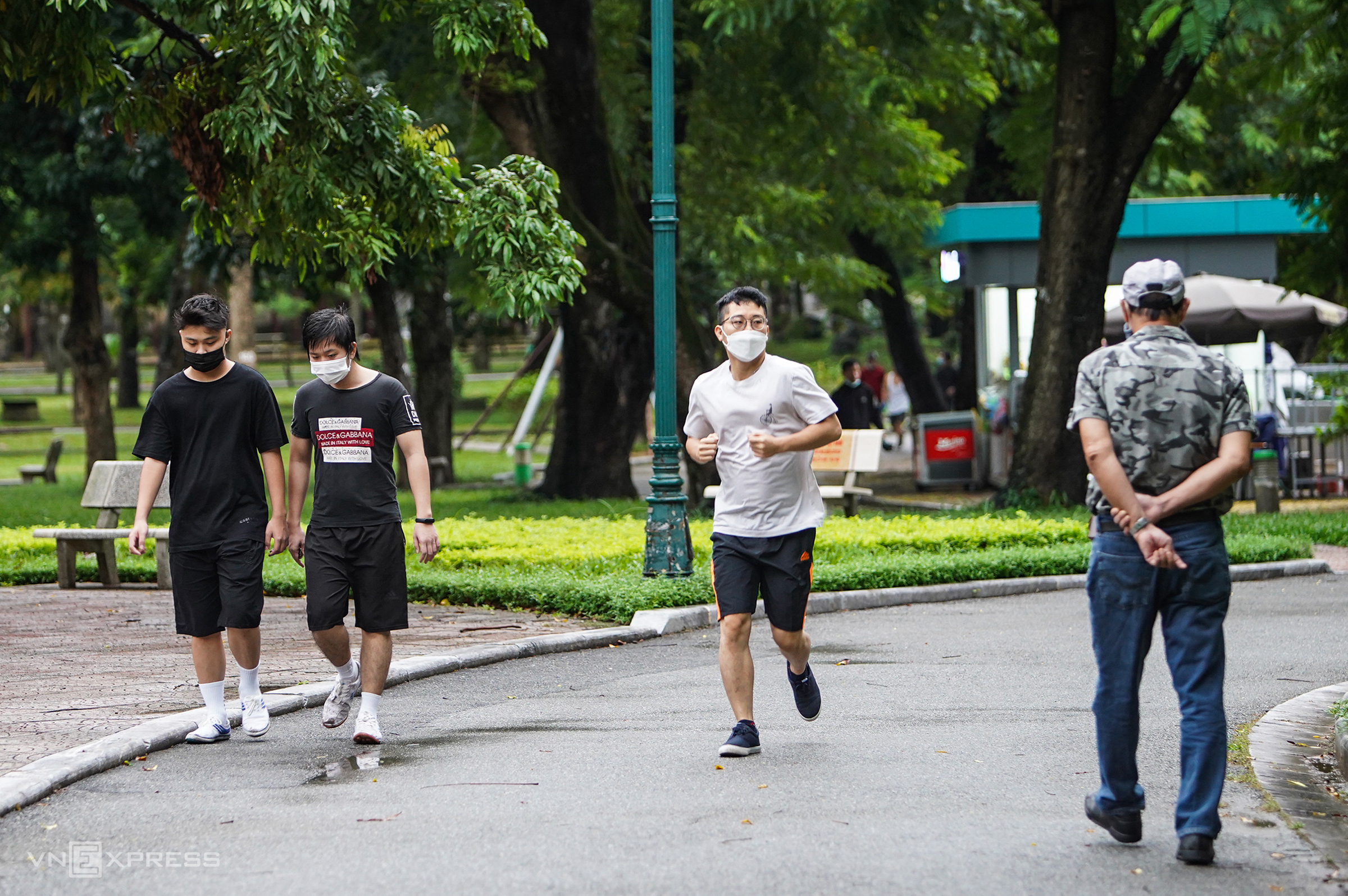 |
|
People walk and jog in a park in Hanoi, October 14, 2021. Photo by VnExpress/Giang Huy |
By the end of October more and more localities began to return to relative normalcy though basic safety measures like wearing masks remained in place.
But in early November the number of daily Covid cases began to rise once again, an expected consequence of resuming economic activities in the new normal.
Vietnam by then had shifted its goal to one of minimizing the number of severe cases and deaths.
On November 3 there were over 7,000 new cases in a single day, the highest in 32 days.
Along with the number of infections, the tally of severe cases and deaths also rose though still much lower than during the worst days of the pandemic.
More and more cases were found in southern localities, with experts believing it was caused by the exodus of migrant workers to their hometowns in the Mekong Delta from epicenter HCMC.
The coronavirus surge caused certain localities, especially those deemed to be at medium and high risk, to bring back certain restrictions. HCMC for instance reversed its decision to reopen bars, dance clubs and karaoke parlors on November 18, just two days after they opened.
Also on November 18 Vietnam’s daily infection tally crossed the 10,000 mark once more, the highest number in 53 days.
A day earlier the country had welcomed its first foreign tourists in two years, with 29 tourists from several countries boarded a Vietnam Airlines plane at South Korea’s Incheon Airport to Da Nang under a vaccine passport program.
In late November the world rippled with news of a new coronavirus variant named Omicron.
It was designated a “variant of concern” by the WHO on November 26 due to its transmissibility and ability to evade immune responses owing to its large number of mutations.
As countries scrambled to enact measures against the variant, Vietnam also put its guard up. But the new variant has yet to be found in Vietnam.
With effect from December 16 the health ministry allows visitors who are vaccinated or have recovered from Covid to quarantine themselves at home and for only three days, followed by another 11 days of self-monitoring. Earlier they had been required to self-isolate for a full 14 days.
Since the end of November Hanoi has slowly been emerging as the country’s coronavirus epicenter.
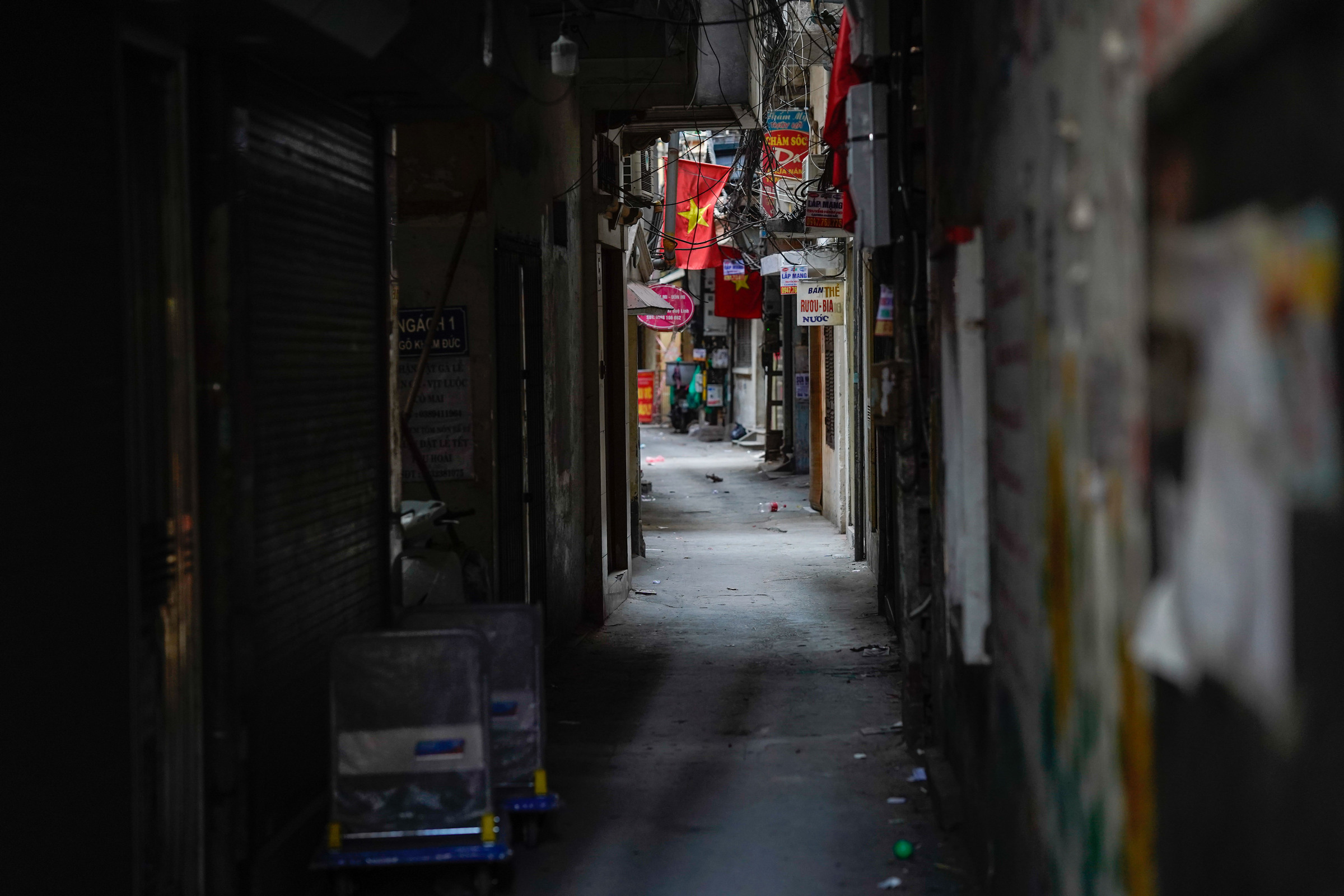 |
|
An alley under Covid-19 lockdown in Hanoi, December 1, 2021. Photo by VnExpress/Pham Chieu |
The number of daily cases was around 100-200 in mid-November, but exploded to 1,000 by mid-December. On December 21 there were 1,704 cases, which took the tally in the new wave to 27,583.
Vietnam has recorded more than 1.58 million cases and 30,251 deaths.
Vaccination campaign
Vietnam began its Covid vaccination campaign, the largest in its history, on March 8, starting with priority groups like health workers, soldiers and those with underlying conditions.
The first vaccine to be approved, in February, was the one produced by AstraZeneca. It was followed by Sputnik V, Sinopharm’s Vero Cell, Pfizer-BioNTech, Moderna’s Spikevax, Johnson & Johnson’s Janssen, Hayat-Vax, and Abdala.
Vietnam secured vaccines for its people either through contracts, global vaccine access mechanism Covax or government aid.
Its vaccination rate was initially slow amid a global vaccine shortage, and the majority of its doses arrived only in the later months of this year.
Thus, starting in March it was only administering a few thousand doses a day, while developed countries raced ahead after managing to secure vaccines early, condemned globally as vaccine ‘apartheid’.
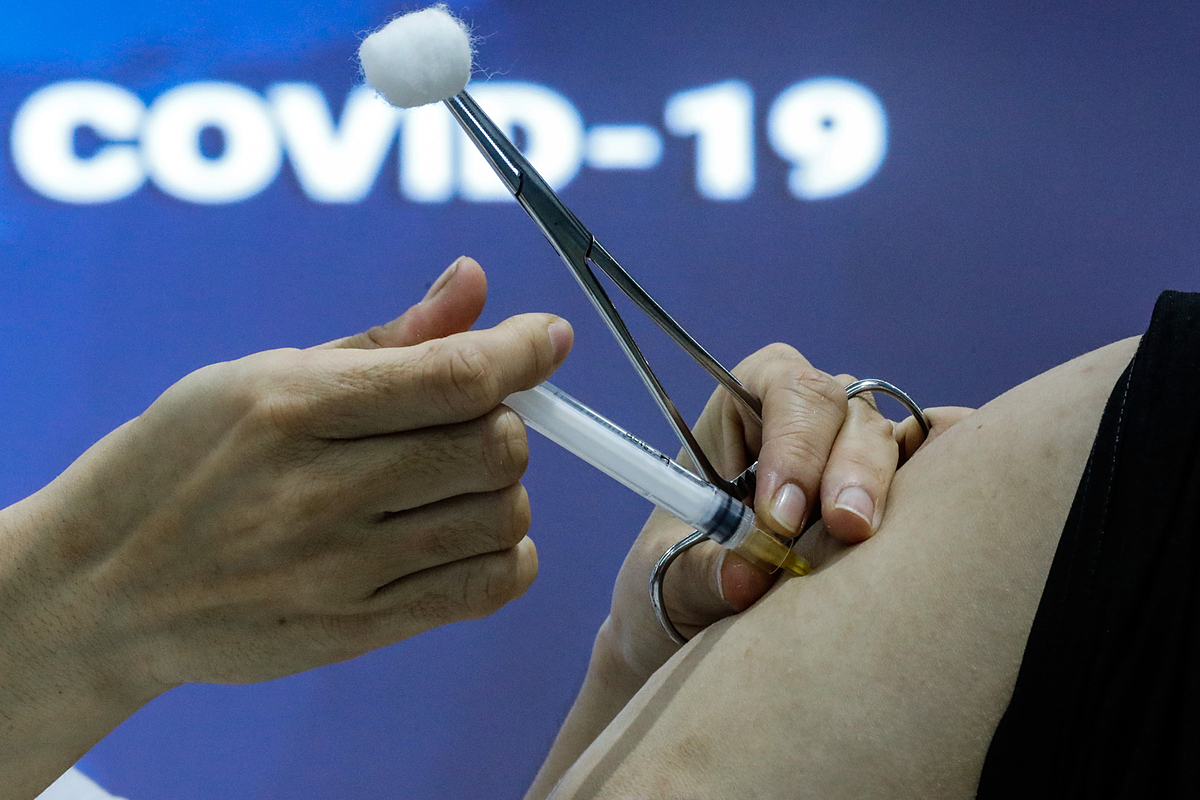 |
|
A medic administers a Covid-19 vaccine shot in HCMC, June 2021. Photo by VnExpress/Huu Khoa |
But the country began to speed things up by the end of July, and by mid-December became the third fastest in the world behind only China and India, vaccinating up to 1.5 million people a day, according to the health ministry.
Starting mid-June, Covid-19 vaccination began for all of Vietnam’s adult population, not just prioritized group. Children aged 12-17 started to be immunized in late October.
The government now plans to give a third shot to all adults by the end of January.
As of December 21 some 77.8 million people had received shots.
Of them, 63.3 million are fully immunized and 1.3 million have even received a booster shot.
- Reduce Hair Loss with PURA D’OR Gold Label Shampoo
- Castor Oil Has Made a “Huge” Difference With Hair and Brow Growth
- Excessive hair loss in men: Signs of illness that cannot be subjective
- Dịch Vụ SEO Website ở Los Angeles, CA: đưa trang web doanh nghiệp bạn lên top Google
- Nails Salon Sierra Madre
 VnExpress News The News Gateway of Vietnam
VnExpress News The News Gateway of Vietnam





